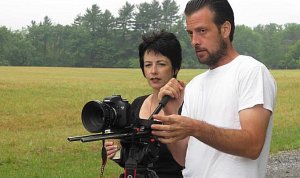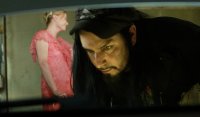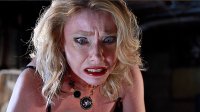|
You have written and executive produced the upcoming movie Model Hunger
- in a few words, what is it about?
Someone once told me that you should always be able
to accurately summarize your script in one sentence.
So my one sentence pitch would be:
Model Hunger
is about a failed model
preying on young women who exhibit body types that elbowed her out of the
industry.
Honestly, that’s only one of three subplots within
the film though. The first
follows Ginny – the failed model – played by Lynn Lowry.
A second follows Ginny’s neighbors, Debbie and Sal – played by
Tiffany Shepis [Tiffany Shepis
interview - click here] and Carmine Capobianco.
And a third follows a television show featuring my good friend Suzi
Lorraine [Suzi Lorraine
interview - click here].
It’s a crazy script performed by a wonderful cast
and engineered by a dedicated crew. All
of which Debbie Rochon [Debbie
Rochon interview - click here] really breathed life into as director and producer.
I've read
somewhere that Model Hunger
is based on a short story of yours
called Ginny - to what extent did your script follow your story,
and why pick this story of yours to begin with?
I wrote the short story Ginny about five years
ago, and it was published about four years ago in the now-defunct Gorezone
(the UK horror fanzine). Ultimately,
the short story served as a springboard for the script. Ginny is told in a sort of stream of consciousness format as
the reader follows (or attempts to follow) Ginny’s internal thoughts
when she encounters a young woman. What
Ginny does to the young woman in the short story is incredibly different
from what happens in the film though.
And the film doesn’t put the audience into Ginny’s mind quite
as much as the short story did.
Instead, while writing the script, I sought to have
a little fun with the reliability of narratives without straying too far
from a conventional linear narrative.
Since I was reading a lot of Gothic-horror works while I was
writing, I wanted to play with the Gothic convention without straying into
Memento territory yet and at the same time avoid being too formulaic.
As M. Night Shyamalan has found out, it’s difficult (if not
impossible) to out-master Hitchcock’s mastery of Gothic storytelling.
Although the film isn’t cut yet, so you never know, Debbie could
always have even more fun with it in post than I had with it in the
writing phase.
As
to why I chose it, I would have to say because the story haunted me.
Once I thought up Ginny, I couldn’t get her out of my head.
Even when we worked on Won Ton Baby!, I was asking the makeup artists on the little downtime we
had about the different ways we could make the film happen.
I felt Ginny’s life was tragic, and I felt personally invested in
it for various reasons. So
once I started working on the script, I put everything I could into it.
What came out was something that I thought was the best script I
had written to date.
What
were your inspirations when writing Model Hunger
(and Ginny,
actually), and to what extent does it reflect your personal views of the
modeling industry?
Everything in my life inspires me as a writer.
One thing I make a concerted effort towards is to remain aware as I
work in the direction of a final draft.
No one can avoid aspects of their life, surrounding culture, works
of literature or film they’ve digested or are digesting, etc. from
seeping into and affecting their creative work.
However, if one slows down, takes a step back from their work, and
analyzes it as they go along, they should be able to recognize things
about themselves and their life that are reflected in their work.
So, for me, the writing process serves as an opportunity to not
only exorcise demons, but to also work through them, comment on them, and
sometimes give a nod and a wink to different groups of people who are to
come across it. I know it’s
cliché to say that writing is therapeutic, but I’d be lying if I said I
don’t use it to that end.
That said, the more direct answer in terms of what
inspired me would be to say that it was the women in my life as well as
some film criticism I had come across at the time.
I was reading some of the work of feminist film theorist/critic
Laura Mulvey as well as the film criticism of Robin Wood – both of which
made me consider how we, as viewers, interact with women on the screen.
Mulvey’s work has been especially vocal about how women are
portrayed in the screen and how we, as viewers, engage them.
Wood was a very passionate critic who championed films that other
critics might turn aside such as Day
of the Dead. Feeling
inspired, I tried to engage their work in my own way.
More importantly though, I’ve had a lot of friends
who have wanted to be models or actresses, and I’ve seen them experience
some rather horrific and unfortunate events in their lives because of
their profession. When I
finally started making films, I came across more actresses and models who
would recall some of the experiences they’d gone through or compromises
they felt they needed to make that were done with the hope of advancing
their careers.
In my opinion, women are faced with an uphill battle
if they want to succeed. And
if they genuinely enjoy something that involves their physical appearance
like acting or modeling, they’re even more limited by the severe lack of
options and a rather obvious double standard.
It should probably go without saying that any actress or model who
gets involved in the industry most likely knows the situation (or has some
idea of it) going in, but I don’t think that should excuse the lack of
interesting roles made available to actresses nor should it excuse the
ridiculous constraints put on models in terms of “beauty.”
Unfortunately, I think the “problem” goes deeper
than just the notion that our society or economic system has a standard of
beauty that’s unattainable. I
think it’s much more insidious than that.
For me, it wouldn’t matter if the standard of beauty shifted; the
system in place would merely adapt to the cultural shift in order to
exploit whatever that new standard is.
With
all those things swirling in my mind, I wrote the script for Model Hunger. How did the project get off the
ground in the first place?
|

Debbie Rochon with Wolfgang Meyer filming
Model Hunger |
Actually, there were several false starts before it
finally got off the ground. The
final draft of the script that I took to investors was finished about
three years ago. In fact, I
pitched the script to my late friend Michael J. Hein (founder of the NYC
Horror Film Festival) [Michael
J.Hein interview - click here] and we’d spoken about him producing it because
I’m pursuing a doctoral degree in literature and I knew that I
wouldn’t have the time to put together all the logistics (logistics
that, thankfully, Greg Lamberson [Gregory
Lamberson interview - click here] – our line producer – and Debbie
would eventually take charge of). In
the meantime, I was working with Shannon Lark [Shannon
Lark interview - click here] to put together a stellar
business plan to raise finances as well as to handle marketing.
Unfortunately, Michael passed away before getting anything formally
off the ground.
From the start, I knew I wanted Debbie Rochon [Debbie
Rochon interview - click here] involved. When we were
shooting Won Ton Baby!, Debbie
and I talked about films as I drove her to and from the set.
The breadth of her film knowledge made me feel like I’d only
scratched the surface of film history (to this day, she will randomly
recommend films noir or marginal directors that I’ve never come across
or have only heard of in passing). She
also kept telling me of this film called Nowhere
Man she was particularly proud of, and when I finally saw it, I not
only enjoyed it, I wondered what sort of film she’d make if she helmed
the production for my script.
I
mentioned to her back then that I thought she should direct a film.
Coincidentally, a couple months later, Greg made the same
suggestion to Debbie while they were working on Slime
City Massacre together. In
fact, Debbie’s apparently been approached multiple times throughout her
career (Lloyd Kaufman told me on the set that he’s been telling her to
direct for years). After Won Ton Baby!,
it became a running theme that whenever Debbie and I would talk, I’d
always ask when she would direct a film.
I told her she just needed to give me a synopsis for a film and
I’d spin it into a script. Eventually,
I decided to ask her if she’d be interested in directing Model Hunger. To my surprise
(and my delight), she said yes.
Model Hunger
is of
course horror icon Debbie Rochon's debut as a director [Debbie
Rochon interview - click here]. Why her, what can you tell us
about Debbie Rochon the director, and what was your collaboration like?
Watching Debbie direct was
an absolute privilege. She
always knows precisely what she wants from an actor.
She has this uncanny ability to know each actor’s limitations and
how to push those limitations without breaking the actor or ruining her
rapport with them.
She also came onboard
incredibly prepared. She had
been working on the visuals for about a year leading up to production.
Knowing in advance exactly what she wanted visually allowed her to
simultaneously get as much out of her DP as possible and to focus her
energies on working with the actors in the moment.
What Debbie did on Model Hunger
as a director was basically demonstrate a clinic on how
to effectively and efficiently direct an independent film.
So to say that collaborating with her was a dream
would be an understatement. When
she agreed to direct the film, I knew from speaking with her that she had
a vision as to what this film could be and what themes as well as what
aesthetics she wished to draw out. Each
time I spoke with her provided another reason to be excited for the
project to come to life. In
the end, I think we have a very special film on our hands – a work that
actually says something, is gorgeous visually, features really powerful
acting, and is highly marketable. That’s
a very rare thing, and it will be a film that everyone involved can be
proud of. I owe Debbie the
world for that.
Considering
you're a director yourself - most notably of Won Ton Baby!,
incidently starring Debbie Rochon [Won
Ton Baby! interview here] -, did you never feel the urge to direct
Model Hunger yourself, and how hands-on or hands-off have you been
as writer/producer when it came to creative decisions?
To be honest, I very much
felt the urge to direct the film because of how much I put into the script
and the rollercoaster ride I’d gone through in getting the film off the
ground. But I also tell people
all the time that not enough independent filmmakers collaborate with one
another, and if we don’t collaborate with new people, we can often find
ourselves repeating the same mistakes we’ve made in the past.
Personally, I feel I have a lot to learn as a director (and
subsequently, watching Debbie direct taught me truckloads), whereas years
of training and working has made me incredibly confident in my writing
skills. I knew I wrote the
best script I could possibly write at the time that I wrote it.
But with my focus on graduate school, directing would have been too
much to handle and far too selfish.
When Debbie accepted my offer to take the helm, I was relieved that
I had made the decision in advance not to direct it because I knew she’d
make it a priority to put all the right specialists in place to fulfill
her vision.
|

Tiffany Shepis |
 |
|

Aurelio Voltaire
(Lynn Lowry in the background) |
Regardless of being producer and writer, I never
wanted Debbie to feel as though her hands were tied to any visuals I might
have had in my mind from when I was writing.
More often than not, ten people can visualize ten completely
different films from reading the same script.
Just as the short story I wrote years ago served as a springboard
for my writing the script, I wanted the script to be a springboard for
Debbie to make the film. So
even though Debbie and I were on the same page with many aspects of the
film, I feel as though the world she created is far more impressive than
the world I would have created. In
that respect, I think a film like this showcases what happens when
creative minds collaborate and aren’t territorial over the material.
A
few words about Model Hunger's cast, and to what extent were you
involved in the casting process?

Lynn Lowry |
The cast is amazing.
I am genuinely afraid of Lynn Lowry and Mary Bogle because of the
power they brought to their performances and the fear that they can evoke
from a viewer. The range of
both Tiffany Shepis [Tiffany
Shepis interview - click here] and Michael Thurber was surreal.
In fact, there were a couple times I couldn’t watch Tiffany’s
scenes because of how moving they were.
Carmine Capobianco and Aurelio Voltaire who are normally known for
their comedic roles also really impressed me with their dramatic work.
Brian Fortune also gave a really gritty performance.
Of course, there was Suzi Lorraine [Suzi
Lorraine interview - click here] who probably gave the craziest
performance of her career thus far and will really take people by surprise
I think. Even minor roles are
filled by such strong talent that it’s difficult not to say enough good
things about the cast.
My involvement in casting was largely listening to
Debbie’s suggestions as to who she thought would be best suited for each
role. She knew exactly the
performances she wanted for each role, and I think each decision she made
was well calculated. Essentially,
I put together auditions in NYC with the help of Kimberly Magness and Adam
Torkel (Greg Lamberson coordinated a couple auditions in Buffalo), and I
also brought on Suzi Lorraine (I’d written the part with her mind,
actually). Aside from that,
the cast was Debbie’s call. What can you tell us
about the actual shoot and the on-set atmosphere?
We had a total of 20 shooting days with two of them
in NYC and the remainder up in Buffalo. NYC
was really fun as we had the privilege of shooting at the School of Visual
Arts thanks to Roy Frumkes and to Greg’s efforts.
Buffalo was also a great experience which involved some typical
horror moments such as a shooting and staying in an apartment building
where at least four deaths took place (and, according to some of our crew,
was supposedly haunted). Greg
worked with the Buffalo Niagara Film Commission to land some interesting
and beneficial locations which assisted to add a much needed dimension to
the film in order to secure Debbie’s vision.
Overall, it was a positive experience with many of
the obstacles and frustrations one expects to have when making an
independent film. Fortunately
we had a great production team that Debbie had largely put in place as we
had talent coming into Buffalo from NYC and LA collaborating with some
cast and crew that Greg had on the ground in Buffalo.
In spite of not knowing one another, everyone gelled and made a
hell of a film. As I said
before, Debbie knew what she wanted from the start, and having an LP like
Greg, a DP like Wolfgang Meyer [Wolfgang
Meyer interview - click here], an SFX artist like Emmy-winner Ingrid
Okola, a sound recordist like Adam Bloch, a production designer like Jen
Morgart, wardrobe designer like Sunny Walker, and all the PA’s who
pitched in made all the difference.
The
$64-question of course: When and where will the film be released,
tentatively? Right now, we’re aiming for 2013.
Debbie has been putting together a terrific post team she can work
closely with, so hopefully we’ll have a few clips ready for AFM in
November and be hitting the festival circuit with the finished product in
the spring. Your/your movie's website, Facebook,
whatever else?
We should be getting the website out in the coming
months, but for now, fans can check out our Facebook page:
www.facebook.com/ModelHunger
as well as our Twitter: @ModelHunger
Also,
check out Debbie’s website: www.debbierochon.com Any future projects beyond
Model Hunger?
Right now, I’m focused on academics.
I have my dissertation on Postwar American Gothic literature and
film to write for my PhD. I’m
also working on an article about Gothic aesthetics in film from the 1920s
up to 1960. It’s an article
I’m really excited about since it’s for a book being published by
Routledge titled The Gothic World.
The book is set to have all the major scholars in Gothic studies
writing articles that will serve as a primer for anyone seeking out
information about Gothic works and culture.
It was a real honor for me to be asked to be involved. I’m
also serving as a reader for a professor working on an article about
Hitchcock and philosopher René Girard.
Outside of critical work, I have a personal rule of
not starting preproduction on a new project until the last one’s been
sold. So I won’t formally
commit to another film until Model
Hunger has a distribution deal in place.
That said, I have a comic book adaptation of Won Ton Baby!
I co-wrote with
Michael Varrati which was illustrated by Keryn Thompson that should be
finished any day now. Michael
wrote an amazingly hysterical storyline and is responsible for the most
hysterical parts of the book. He
went through an English graduate program like myself, so it’s always a
blast to collaborate with him and trade war stories about academic life.
Meanwhile, Keryn has done a wildly fantastic job with the visuals
and she’s someone I think has a really bright future as an artist.
The comic book is something I’m really excited to get it out to the
public. I’m also itching to collaborate with a number of
filmmakers like Michael Varrati, Shannon Lark [Shannon
Lark interview - click here], Crispin Glover, Joe Hollow [Joe
Hollow interview - click here],
Jennifer Morgart, and others. I
have over a dozen scripts (including a sequel to Won Ton Baby!
and a prequel to Model Hunger)
and two Gothic novels I’ve set on the backburner until I find the right
amount of time to dedicate to them. I’m
also just so grateful to Debbie, and enjoy so thoroughly what she’s put
together, that I’d be thrilled to collaborate with her as director again
in the future. But we’ll
see. The film has to be put
out first, and finishing school is a priority for me.
 |
Feeling lucky?
Want to
search
any of my partnershops yourself
for more, better results?
(commissions earned) |
The links below
will take you
just there!!!
|
|
 |
In
addition to all the creative and academic work, I also serve as the
Director of Media and Distribution for Viscera Film Festival
(www.viscerafilmfestival.com).
It is a non-profit women’s horror film festival founded by
Shannon and co-directed by her and Heidi Honeycutt that
helps to promote female horror filmmakers and to push against what Lloyd
Kaufman has astutely identified as the “blood ceiling” in the indie
horror industry. We toured the
festival in over 20 cities across the world last year and have been
featured on two university campuses so far – this past year Shannon even
secured the famous Grauman’s Egyptian Theatre on Hollywood Boulevard for
the main event. My involvement
with the festival is something I am extremely proud of, and if we can keep
the same core of people involved, I think we can continue to grow it
exponentially over the next decade. Unfortunately,
being non-profit presents many financial burdens and hurdles. Anything else you are dying to mention and I
have merely forgotten to ask? No, sir!
Thanks for the interview!
Thank you!
|